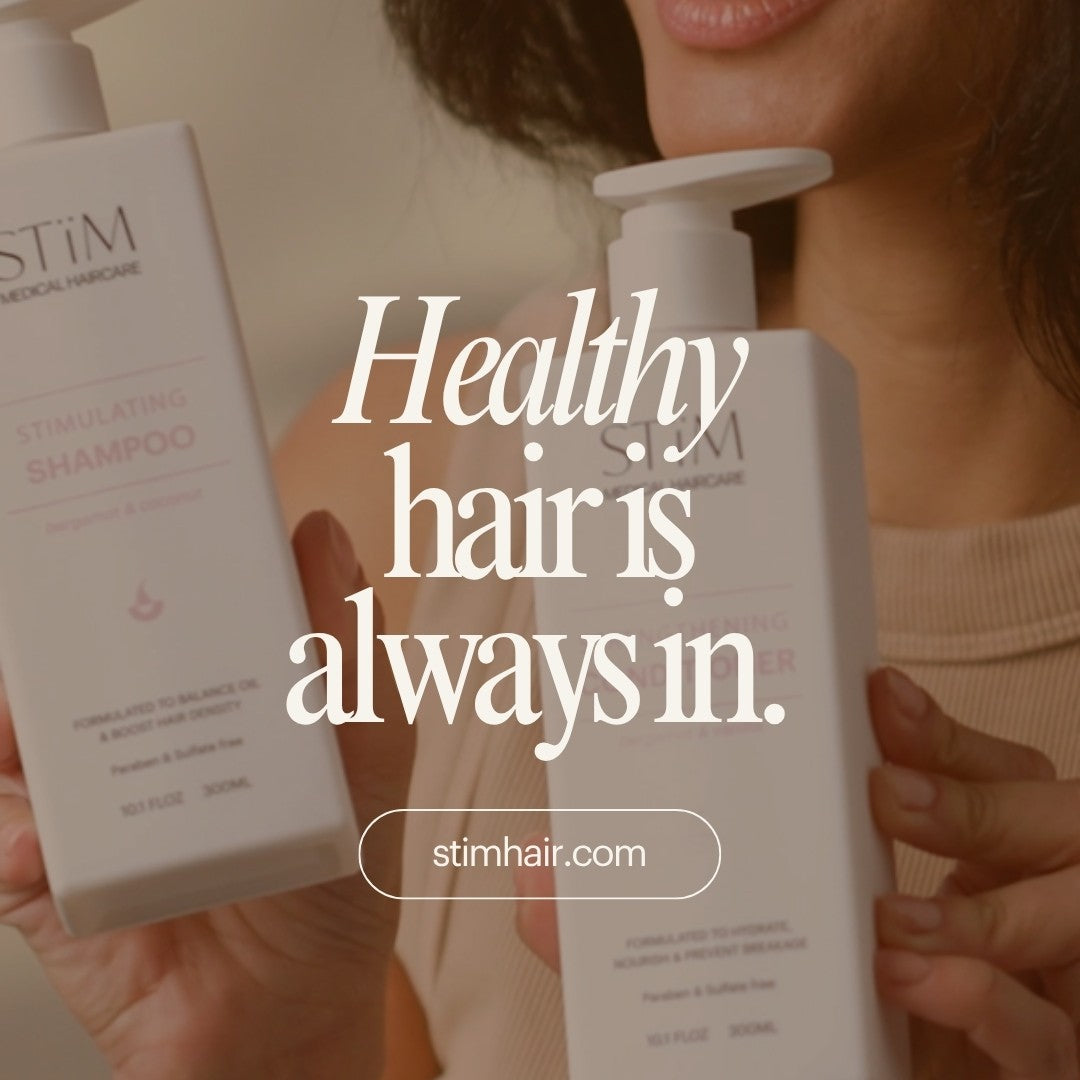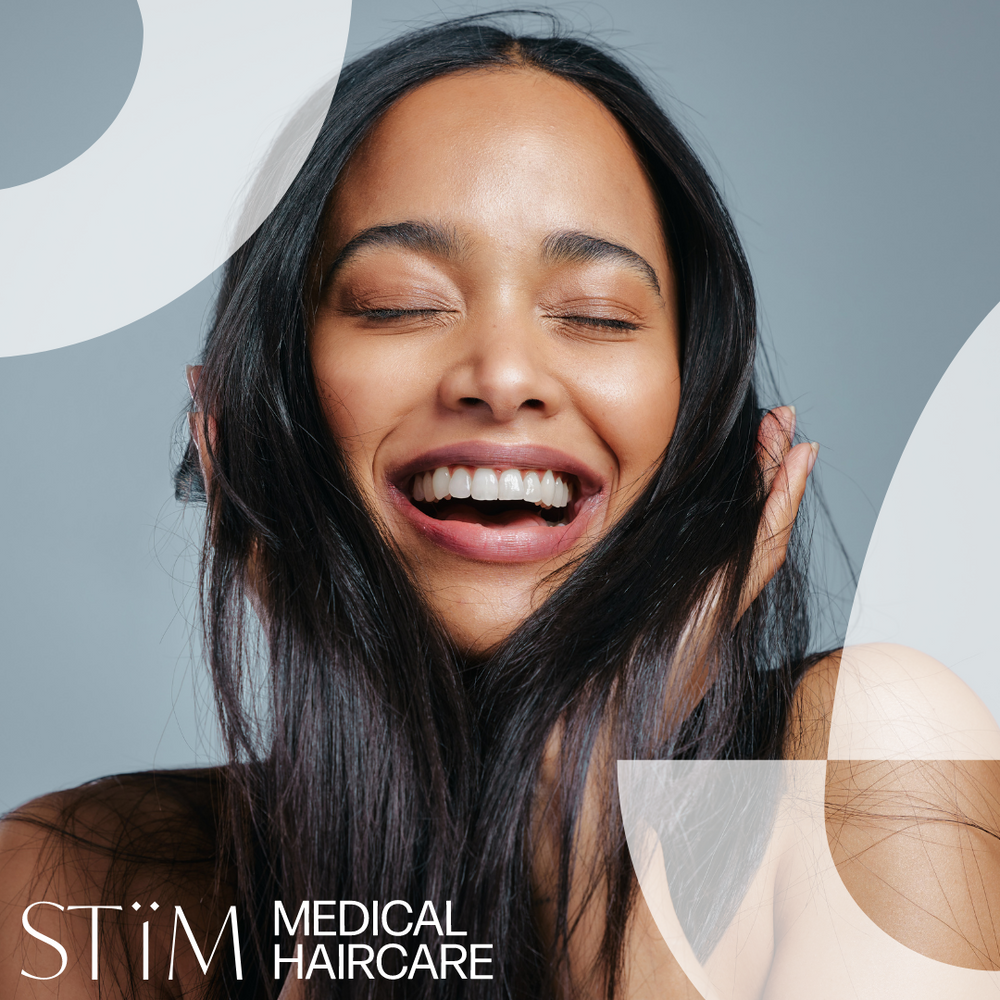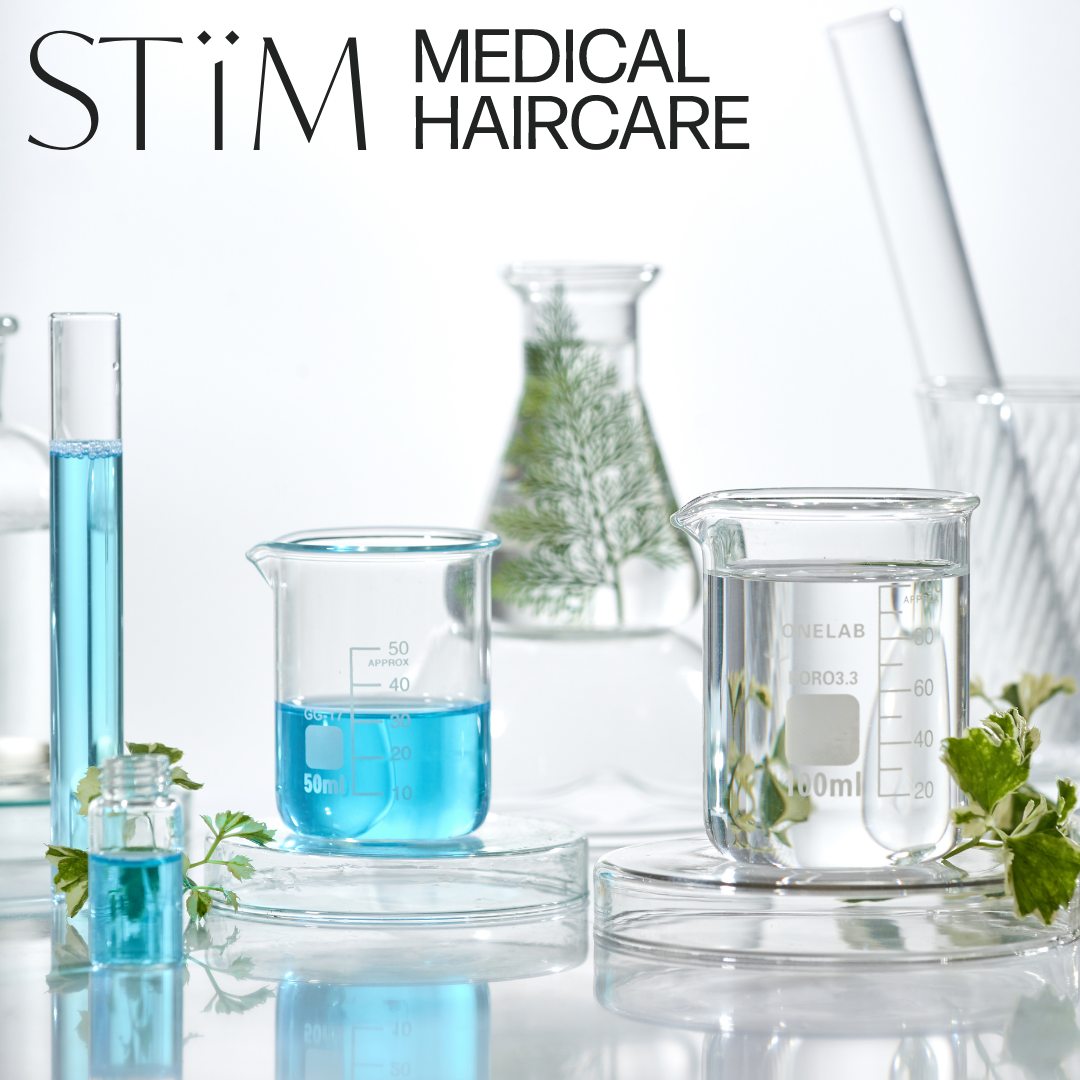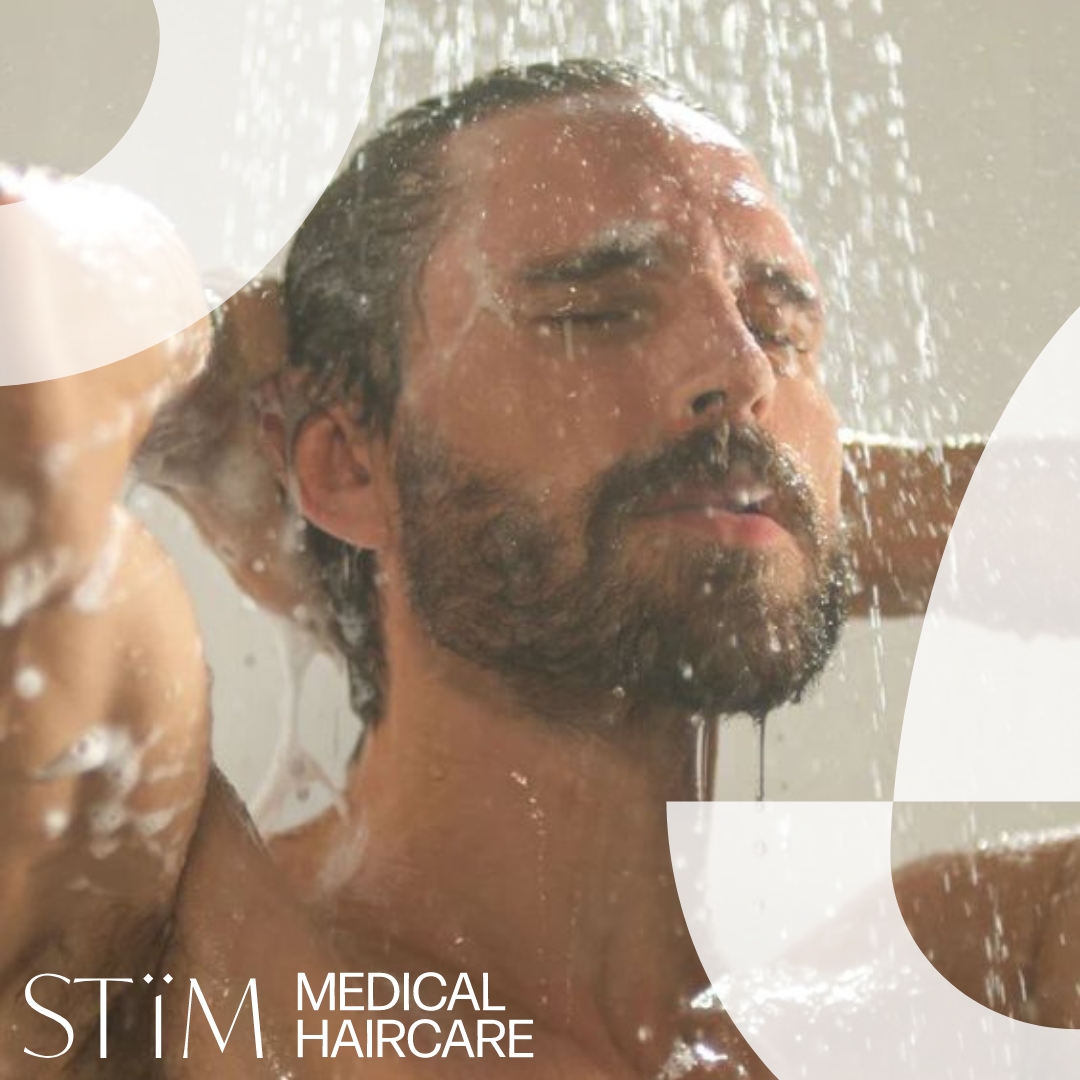How to Improve Scalp Health: 12 Proven Tips for Hair Growth

Your scalp is more than simply hair’s base; it is a living ecosystem where balance, hydration and calm immunity foster strength from the roots. A truly healthy scalp boasts a stable microbiome, well-hydrated skin and minimal inflammation. When any of these elements falter—be it through harsh chemicals, nutritional gaps or environmental stress—you may notice dandruff, persistent itchiness, brittle strands, uneven growth or accelerated thinning.
Drawing on the NHMRC’s nutrient reference values for Australia and New Zealand, landmark PubMed studies on scalp dysbiosis, and the marriage of botanical actives with clinically proven science such as Stïm Haircare’s Nano™ T-Growth technology, this guide delivers twelve evidence-based, actionable tips. You will learn how daily rituals, targeted nutrition, microbiome-friendly practices and professional treatments combine to revitalise your scalp and promote lasting hair growth.
First up, choose a gentle, scalp-nourishing shampoo to set the stage for healthier hair.
1. Choose a Gentle, Scalp-Nourishing Shampoo
Your shampoo is your first line of defense in maintaining a balanced, healthy scalp. A well-formulated cleanser removes excess sebum, styling product and environmental pollutants without stripping away the skin’s protective oils or upsetting its microbiome. Look for a pH-balanced formula—which typically sits around pH 5–5.5—to support your scalp’s natural barrier, and tailor wash frequency to your hair type:
- Oily or fine hair: 3–4 times per week
- Normal hair: 2–3 times per week
- Dry, textured or curly hair: 1–2 times per week
For example, Stïm Haircare’s Stïmulating Shampoo is sulphate- and paraben-free, enriched with caffeine, saw palmetto and essential vitamins, so your scalp stays nourished long after you rinse.
Identify Harsh Ingredients on Labels
When you scan an ingredient list, watch out for common irritants and microbiome disruptors:
- Sulfates (e.g. sodium lauryl sulphate, sodium laureth sulphate)
- Parabens (methylparaben, propylparaben)
- Drying alcohols (SD alcohol-40, isopropyl alcohol)
- Synthetic fragrances (often listed simply as “parfum”)
- Harsh preservatives (DEA, TEA, MEA)
Tip: Ingredients are listed in order of concentration. If any of these appear in the first five components, consider a gentler alternative.
Scalp-First Application Technique
- Wet hair thoroughly with lukewarm water.
- Dispense a small amount of shampoo into your palms—roughly a 2 cent piece.
- Focus the product on your roots and hairline.
- Gently massage in circular motions for 2–3 minutes, using fingertip pressure to boost circulation without scratching.
- Allow the lather to run down the lengths as you rinse, then repeat only if needed.
By prioritising the scalp and massaging deliberately, you ensure active ingredients reach the follicles where they can encourage stronger, healthier growth.
2. Condition Correctly to Maintain Scalp Moisture
A good conditioner does more than detangle—when chosen and applied smartly, it also reinforces your scalp’s moisture barrier. By smoothing the hair cuticle and sealing in hydration, you prevent water loss from both strands and skin. Over time, well-conditioned locks are less prone to breakage, split ends and the flakiness that can come from a dry, irritated scalp.
Not all conditioners belong on the roots. If you have fine or oily hair, concentrate on the mid-lengths and ends to avoid weighing down your scalp. Those with dry, textured or curly hair can benefit from a light layer of conditioner creeping up towards the hairline—just be sure it’s free from heavy silicones or waxes that might clog pores. As a rule of thumb:
- Fine or oily hair: condition 1–2 times a week, focusing below the crown
- Normal hair: condition 2–3 times a week, from mid-lengths to ends
- Dry, curly or coarse hair: condition every wash, applying from scalp to tips
By tailoring both the formula and frequency to your unique texture, you maintain a well-hydrated scalp without the greasy buildup that can fuel dandruff or itchiness.
Top Humectants for Scalp Hydration
Humectants draw moisture into the skin, supporting hydration from the surface down to the follicle. Common, scalp-friendly humectants include:
- Panthenol (pro-vitamin B5): penetrates the hair shaft, locking in moisture and enhancing elasticity
- Glycerin: attracts water molecules, softening both scalp and strands
- Niacinamide (vitamin B3): improves barrier function, reducing transepidermal water loss
- Hyaluronic acid: holds up to 1,000 times its weight in water, plumping the skin and reducing dryness
When these ingredients appear near the top of your conditioner’s list, you know they’ll play a leading role in combating tightness and flakiness.
Correct Conditioning Technique
- Rinse out shampoo completely with lukewarm water—residual cleanser can interfere with conditioning.
- Squeeze out excess water so the conditioner doesn’t slide off.
- Place a small dollop of conditioner into your fingertips, then gently work it through your hair where needed.
- Use a wide-tooth comb to distribute the product evenly, especially if your hair is curly or prone to tangles.
- Leave the formula on for 2–3 minutes to allow humectants to bind moisture, then rinse with cool water to seal the cuticle.
By applying with care—rather than slapping conditioner all over—you target only areas that need the extra boost, preserving your scalp’s delicate oil balance while keeping hair soft and manageable.
3. Exfoliate and Scrub to Remove Build-Up
Even the gentlest shampoos can leave behind sebum, dead skin cells and traces of styling products that clog follicles and dull hair. Regular exfoliation clears this debris, creating a cleaner environment for active ingredients to penetrate and support a healthy scalp. By removing buildup, you’ll help prevent itchiness and flaking while giving serums, masks and treatments a better chance to work.
Exfoliation needn’t be harsh or abrasive. Whether you prefer a gentle daily polish or an occasional deeper cleanse, choosing the right method and frequency will safeguard your scalp’s barrier and maintain its natural microbiome.
Physical vs Chemical Exfoliation
Physical exfoliants rely on small particles or tools to manually scrub away debris:
- Pros: instant smoothing, easy to feel and control, often DIY-friendly
- Cons: risk of micro-tears if particles are too coarse or you scrub too hard
Common physical options include brown sugar, finely ground salt or silica-based beads. You can also use a soft brush or silicone massager to boost circulation while you scrub.
Chemical exfoliants use acids to dissolve dead skin and excess oil:
- AHAs (alpha-hydroxy acids) like glycolic or lactic acid: excellent for surface renewal
- BHAs (beta-hydroxy acids) such as salicylic acid: penetrate oilier scalps to clear within follicles
Chemical scrubs are ideal for those who prefer a gentler, no-rubbing approach, but be mindful of potential sensitivity. Always patch-test a small area and follow usage instructions to avoid irritation.
DIY Scalp Scrub Recipe
Creating a homemade scrub is simple, cost-effective and lets you customise the formula. For a balanced blend of gentle abrasion, hydration and antimicrobial support, try this recipe:
Ingredients:
- 2 tablespoons brown sugar (fine grain)
- 1 tablespoon melted coconut oil
- 5 drops tea tree essential oil
Method:
- In a small bowl, stir the brown sugar and coconut oil until you have a wet sand consistency.
- Add tea tree oil and mix thoroughly—its natural antifungal properties help keep the scalp fresh.
- After shampooing, squeeze out excess water and gently work the scrub into your roots using fingertip pressure.
- Massage in circular motions for 1–2 minutes, focusing on areas that feel tight or flaky.
- Rinse thoroughly with lukewarm water and follow with your regular conditioner.
Safety tips:
- Use this scrub no more than once a week to avoid over-exfoliation.
- If you experience redness or stinging, reduce frequency or switch to a milder chemical exfoliant.
- Always follow up with a hydrating conditioner or leave-in serum to replenish moisture.
By incorporating regular scalp exfoliation—whether through physical scrubs or gentle chemical treatments—you’ll maintain clear follicles, enhance product absorption and set the stage for stronger, shinier hair.
4. Perform Regular Scalp Massages
Stimulating your scalp through massage is one of the simplest yet most effective ways to promote circulation, deliver nutrients to hair follicles and relieve tension that can stifle growth. Aim for a brief session—around 5 minutes—three to five times a week. Whether you prefer your fingertips or a gentle brush, the key is consistent, pressure-controlled movement that never tears or scratches the delicate skin of your scalp. Over time, regular massage can help strengthen the root environment, reduce stress-induced tightness and even enhance the penetration of your favourite serums and treatments.
Manual vs Tool-Assisted Massage
When you use your own fingertips, you have complete control over pressure, direction and the areas you target. Fingertip massage is ideal for spotting tight spots, small lumps or flaky patches. The warm, palm-to-scalp contact also feels deeply relaxing—perfect if you’re looking to unwind.
Tool-assisted massage, by contrast, can deliver a more uniform, deeper stimulation. Silicone brushes or soft-tipped massagers spread pressure evenly and may help dislodge stubborn buildup in hard-to-reach nooks. Just remember to choose a tool with rounded bristles or nodules and clean it regularly to avoid transferring oils or product residue back onto your scalp.
Incorporating into Daily Routine
- Shampoo or conditioner massage: While your chosen cleanser or treatment is sitting on your scalp, use gentle, circular strokes to work it in. This dual action both cleanses and invigorates.
- Pre-bed ritual: Warm a few drops of specialised scalp serum between your palms, then massage the scalp in small circles. Not only does this nourish overnight, but the ritual itself can signal your body that it’s time to wind down.
- Screen-break stretch: Set a reminder every couple of hours. Stand up, lean forward and use your fingertips to massage the top and back of your head. You’ll break the sedentary cycle and give your scalp a quick boost.
By weaving these brief, simple sessions into routine tasks, you’re more likely to stick with them—and over time, you’ll notice your scalp feeling more supple, your hair growing stronger and the whole experience becoming a relaxing highlight of your self-care ritual.
5. Maintain a Balanced Scalp Microbiome
Your scalp is home to a diverse microbial community—bacteria, fungi and even tiny viruses—that work together to keep the skin barrier strong and inflammation at bay. Clinical research, including a recent PubMed study on the scalp microbiome, shows that when this ecosystem is thrown out of whack (dysbiosis), common complaints like dandruff, seborrheic dermatitis, psoriasis and even alopecia areata can flare up.
Unlike a one-size-fits-all approach, supporting your microbiome means gently encouraging beneficial microbes while discouraging overgrowth of opportunistic species. By avoiding overly harsh cleansers and sticking to routines that respect your scalp’s natural pH and oil balance, you’ll set the stage for healthier skin and stronger hair growth.
Beneficial vs Harmful Microbes
A handful of key organisms tend to dominate a healthy scalp:
- Malassezia: a lipophilic yeast that, in balance, helps maintain skin barrier function
- Staphylococcus caprae: a commensal bacterium linked to reduced inflammation
- Corynebacterium: another resident group associated with normal scalp ecology
However, when Malassezia populations rise unchecked—“Increased Malassezia…linked to dandruff”—you’ll often see flaking, itchiness and irritation. Meanwhile, shifts in Staphylococcus or Corynebacterium levels can leave the skin more vulnerable to redness or sensitivity. Keeping these populations in harmony is crucial.
Practices to Support Microbial Balance
- Use a pH-balanced cleanser (around pH 5–5.5) to preserve the acid mantle that beneficial microbes thrive in.
- Avoid daily shampooing unless you have very oily hair—typically 2–4 washes per week is enough to prevent both buildup and over-stripping.
- Steer clear of antiseptic or antibacterial products aimed at a “deep clean,” which can kill off helpful species and invite dysbiosis.
- Consider a gentle probiotic or antifungal shampoo if you’re prone to recurring flaking; ingredients like zinc pyrithione or piroctone olamine can selectively target Malassezia without wrecking bacterial diversity.
- Rinse thoroughly after any topical treatment to prevent residue from becoming a breeding ground for unwanted microbes.
By treating your scalp as a living ecosystem rather than a blank slate to be scrubbed clean, you encourage a resilient barrier—one that resists inflammation, supports hair follicles and keeps your strands looking and feeling their best.
6. Eat a Nutrient-Rich Diet
Your scalp’s health is nourished from the inside out. A varied diet supplies the proteins, healthy fats and micronutrients that drive cell division in hair follicles, support sebum balance and keep the skin barrier supple. Rather than relying solely on supplements, focus on whole foods that naturally deliver hair-friendly vitamins and minerals.
The NHMRC’s nutrient reference values highlight key intakes for optimal health, including hair growth. Use the following guidelines to plan meals that feed your follicles and fortify your scalp.
Biotin for Keratin Production
Biotin (vitamin B7) plays a starring role in keratin synthesis—keratin being the protein your hair shafts are made from. Without enough biotin, strands can become brittle and prone to breakage.
- NHMRC adequate intake: around 30 µg per day for adults
- Top food sources:
• Eggs (yolks are especially rich)
• Almonds, walnuts and peanuts
• Legumes such as chickpeas, lentils and beans
• Whole grains (oats, brown rice)
Try a poached egg on wholegrain toast for breakfast or toss a handful of nuts into your afternoon salad. These simple swaps make it easier to hit your biotin targets without thinking twice.
Zinc and Iron for Follicle Function
Zinc and iron are vital cofactors for enzymes that regulate hair cell growth and repair. Low levels can slow down the growth cycle or trigger excessive shedding.
- Zinc RDI:
• Men: 14 mg/day
• Women: 8 mg/day - Iron RDI:
• Men: 8 mg/day
• Women (19–50 yrs): 18 mg/day
Rich sources include:
• Red meat, poultry and pork (haem iron for efficient uptake)
• Oysters, crab and other shellfish (zinc power-houses)
• Spinach, kale and other leafy greens (non-haem iron)
• Pumpkin and sesame seeds
To boost non-haem iron absorption, pair plant-based iron sources with vitamin C–rich foods (think lemon-dressed spinach). And if you snack on pumpkin seeds between meals, you’ll be topping up your zinc stores to keep follicles firing on all cylinders.
7. Stay Hydrated for Scalp Health
Water isn’t just vital for your overall well-being; it directly affects the moisture balance of your scalp. When your body is dehydrated, the skin’s barrier can become compromised, leading to a tight, flaky scalp and increased itchiness. Adequate hydration helps maintain your scalp’s elasticity and supports sebum distribution, which in turn keeps both skin and hair shafts supple. Aim for around 2–3 litres of water per day—adjusting for your activity level and the Australian climate—and watch for signs of dehydration such as dark urine, persistent thirst, dry skin or that tell-tale scalp tightness.
Hydration Tips Beyond Water
- Include water-rich foods in your diet. Cucumber, watermelon, celery and oranges each contain over 90 per cent water, helping you meet your hydration goals while supplying vitamins and antioxidants.
- Sip herbal teas or infused water. Mint, chamomile or ginger infusions add flavour without caffeine, encouraging you to drink more throughout the day.
- Use a humidifier in dry environments. Indoor heating or air-conditioning can sap moisture from the air (and your scalp), so aim for a humidity level around 40–60 per cent.
- Try a water-based leave-in spray or aloe vera mist. Light spritzes can soothe transient tightness and refresh your scalp between washes, especially in hot weather.
By combining sufficient fluid intake with supportive habits, you’ll give your scalp the hydration it needs to stay healthy—and your hair the optimal environment for growth.
8. Use Targeted Scalp Treatments
Beyond cleansing and conditioning, specialised scalp treatments—serums, masks and botanical oils—deliver concentrated actives where your skin needs them most. Whether you’re tackling dryness, irritation or circulation, these formulations can supplement your routine and address underlying concerns.
Look for masks that combine humectants and soothing extracts, such as aloe vera or oat peptide, to replenish moisture and calm inflammation. A weekly 10–15-minute mask application gives skin a chance to absorb rich emollients and restore its natural barrier. In contrast, daily serums or tonics packed with lightweight actives—think caffeine, peptides or tea tree oil—can help invigorate follicles, regulate oil production and prevent flaking. Many serums use Nano™ T-Growth encapsulation (as seen in Stïm Haircare’s Growth Tonic) to release potent ingredients gradually, extending their benefit throughout the day.
By layering treatments in this way—mask once or twice a week, serum each morning or evening—you customise your scalp care and target specific issues without overloading the skin.
Hydrating Oils vs Therapeutic Serums
Hydrating oils like jojoba, argan or rosehip act primarily as occlusives: they sit on the skin’s surface to lock in moisture, support the lipid barrier and deliver nourishing fatty acids. These oils are ideal if your scalp feels tight, flaky or prone to redness. Apply a few drops, massage gently, leave on for at least 30 minutes (or overnight) and then shampoo as usual to remove any excess.
Therapeutic serums, on the other hand, focus on potent actives in a water- or silicone-based base. Ingredients such as caffeine, niacinamide, zinc pyrithione or botanical antifungals (e.g. tea tree) can address specific concerns like oil regulation, microbial balance or inflammation. Serums absorb quickly without leaving a greasy film—perfect for daily use before styling or under other products.
Choose oils when your priority is hydration and barrier repair; choose serums when you need targeted delivery of scalp-beneficial actives.
Safe Application of Scalp Treatments
Even the gentlest formulations can cause irritation if over-used or applied incorrectly. Always perform a patch test—dab a small amount of product behind your ear or on your inner forearm and wait 24 hours to check for redness or itching.
To prevent product buildup, follow these guidelines:
- Use masks no more than once or twice weekly.
- Limit oil treatments to a few nights per week, especially if your hair is fine or prone to greasiness.
- Apply serums sparingly—usually 3–5 drops are sufficient for the entire scalp.
Rinse oils and masks thoroughly during your next wash, and rotate between different active serums if you find your skin becoming sensitised. By respecting these protocols, you’ll enjoy the full benefits of targeted treatments without compromising your scalp’s delicate equilibrium.
9. Protect Your Scalp from External Stressors
Your scalp faces more than shampoos and serums—it’s exposed to UV radiation, heat styling and environmental pollutants that can weaken its barrier, accelerate free-radical damage and trigger inflammation. Sunburn on the scalp isn’t just uncomfortable; it dries out skin, contributes to premature ageing and may even impair follicle health. Similarly, excessive heat from styling tools strips away moisture, roughens the cuticle and makes strands prone to breakage. Urban pollution—fine particulate matter, smoke and exhaust—settles on the skin, clogs pores and fuels oxidative stress.
Mitigating these external aggressors requires a multi-layered approach: physical coverage, topical shields and heat-smart styling. By weaving in simple protective measures—hats, specialised sprays and mindful tool use—you’ll preserve both your scalp’s hydration and the integrity of each follicle.
UV Protection Tips
Sun safety for your scalp begins with applying a broad-spectrum sunscreen made for sensitive skin. Look for mineral filters such as zinc oxide or titanium dioxide in a lightweight, non-greasy spray or lotion so you can target exposed parts of your scalp (along the hairline and part). Aim for SPF 30 or higher and reapply every two hours if you’re outdoors.
If sunscreen isn’t your style, opt for physical barriers:
- Wear a wide-brimmed hat or baseball cap with a built-in sweatband to absorb oil and wick moisture.
- Choose scarves or caps made from UPF-rated fabrics (UPF 30+ blocks over 95% of UV rays).
- Seek out sun-protective headwear designed for sports or gardening—many brands use breathable, moisture-wicking materials to keep you cool.
By combining sunscreen and sun-smart accessories, you’ll guard the delicate skin of your scalp and prevent the dryness and inflammation that follow UV overexposure.
Heat Styling Best Practices
When you reach for a hairdryer, straightener or curling iron, start by lowering the temperature. Stick to low-medium heat (around 150–180 °C) and allow your hair to air-dry partially to reduce styling time. Before any hot-tool session, mist on a heat protectant—look for formulas containing silicones (cyclomethicone, dimethicone) or panthenol, which form an insulating film over the cuticle.
Additional tips for gentle styling:
- Use a microfiber towel or soft cotton T-shirt to blot excess water—vigorous rubbing can weaken strands and aggravate the scalp.
- Hold tools at least 2 cm from the root to minimise direct heat on skin.
- Finish with a cool-shot from your hairdryer to help seal the cuticle and lock in moisture.
- Limit heat styling to no more than 2–3 times per week, giving your scalp and strands time to recover.
By treating your scalp as you would the rest of your skin—shielding it from heat and replenishing moisture—you’ll reduce the risk of dryness, irritation and long-term damage, keeping both your scalp and hair looking their healthiest.
10. Manage Stress to Prevent Scalp Issues
Stress triggers a cascade of hormonal changes—most notably an increase in cortisol—that can inflame the scalp and disrupt the hair growth cycle. Chronically elevated cortisol levels spur inflammation around follicles, impair nutrient delivery and push hairs prematurely into the resting (telogen) phase. The result? Diffuse shedding, slower regrowth and a scalp that feels tight or itchy. By tackling stress head-on, you can recalibrate your body’s responses, soothe inflammation and support steady, healthy hair growth.
Simple stress-management strategies—yoga, meditation and good sleep—help lower cortisol, calm inflammatory signals and restore balance to your scalp’s ecosystem. Consistency is key: weaving a few minutes of relaxation into your daily routine can yield visible benefits for both your scalp comfort and hair density.
Quick Stress-Reduction Techniques
Short, focused breaks throughout the day can reset your nervous system and sharpen your scalp’s resilience to stress. Try these mini-tools:
- 4-7-8 Breathing: Inhale for 4 counts, hold for 7, exhale for 8. Repeat 4 cycles to ease tension.
- Box Breathing: Breathe in for 4, hold for 4, exhale for 4, hold for 4. Great for desk breaks or on public transport.
- Mindful body scan: Sitting or lying down, close your eyes and mentally scan from your scalp to your toes, releasing tightness as you go.
- Stress-management apps: Headspace, Calm or Insight Timer offer guided sessions as short as 2–5 minutes—perfect when time is tight.
Integrating these mini-routines can lower anxiety, improve scalp blood flow and curb stress-induced scalp issues before they spiral.
Sleep Hygiene for Scalp Recovery
High stress often goes hand-in-hand with poor sleep, which then amplifies cortisol spikes and heightens inflammation. Aim for 7–9 hours of restful sleep each night to give your body—and scalp—time to repair. Good sleep habits include:
- Consistent schedule: Go to bed and wake up at the same time, even on weekends, to regulate your circadian rhythm.
- Pre-sleep ritual: Ditch screens an hour before bedtime. Read, stretch or practise gentle breathing to wind down.
- Sleep environment: Keep your room cool, dark and quiet. Use blackout curtains, a white noise machine or earplugs if needed.
- Limited caffeine: Avoid stimulants after mid-afternoon to prevent sleep fragmentation.
By treating sleep as a foundational part of your scalp-care regimen, you’ll support natural hormone cycles, reduce inflammation and give hair follicles the optimal conditions for new growth.
11. Avoid Harsh Chemical Treatments
Strong chemical services—such as bleach lightening, perming or high-lift dyes—can deliver dramatic colour and texture changes, but they often do so at the expense of your scalp’s health. Chemicals like ammonia, peroxide and alkaline developers lift the hair cuticle and break down natural proteins; in the process they can also compromise the lipid barrier of your skin, leaving it dry, inflamed and more susceptible to infection. Repeated exposure may slow hair-growth cycles, increase breakage and even scar follicles, leading to long-term thinning.
Rather than letting impatience or a desire for frequent style changes dictate your routine, it’s best to space out these chemical treatments and choose gentler formulations whenever possible. Always perform a patch test at least 48 hours before any new service, and allow a minimum interval of 4–6 weeks between bleaches or perms to give your scalp time to recover. When booking with a stylist, discuss the strength of developers, pH levels and potential bonding protectors that can help mitigate damage.
Recognising Scalp Reactions
Even when precautions are taken, your skin may send warning signals during or after a chemical service. Look out for:
- Redness or swelling along the hairline
- Persistent burning, stinging or sharp tingling sensations
- Small blisters, hives or open sores
- Excessive flaking, scaling or crusting
- Sudden, patchy hair shedding in treated areas
If you experience any of these symptoms, rinse your scalp immediately with cool water—avoid hot water, which can exacerbate irritation. Gently cleanse with a mild, pH-balanced shampoo to remove residual chemicals, then soothe the area with a fragrance-free conditioner or a calming aloe-based mask. If redness or discomfort persists beyond a few hours, seek advice from a dermatologist to prevent secondary infection or lasting damage.
Gentler Alternatives
You don’t have to forgo all colour or curl to keep your scalp happy. Consider these lower-risk options:
- Plant-based dyes: Henna and indigo strengthen the hair shaft and deposit rich pigments without ammonia or peroxide, though results can vary and require a strand test first.
- Demi-permanent or semi-permanent shades: These use milder oxidants and gradually fade, minimising cuticle disruption.
- Temporary colour sprays and chalks: Ideal for special occasions, they rinse out with one or two washes and pose no long-term risk.
- Clip-in extensions and coloured wefts: Add volume, length or contrast without touching your own hair or scalp with harsh chemicals.
By choosing softer approaches and respecting the recovery time between treatments, you preserve your scalp’s integrity—so that every application leaves you looking refreshed, not frustrated, and your hair can continue to grow strong and healthy.
12. Consult a Professional for Persistent Issues
Even the most diligent home routine can fall short when underlying medical factors are at play. If you experience any of the following red-flag symptoms, it’s time to seek expert advice:
- Severe or constant itching, burning or pain
- Sudden, patchy hair shedding or rapid thinning
- Visible sores, pustules or unexplained scaling
- Persistent flakiness despite targeted treatments
A qualified dermatologist or trichologist can pinpoint the root cause—whether it’s a skin condition, hormonal imbalance or nutrient deficiency—and recommend tailored solutions. Stïm Haircare also offers a free online hair health quiz and tele-consultations, so you can explore prescription-strength options without leaving home.
Getting Started on a Healthier Scalp
Embarking on a scalp-care routine can feel overwhelming if you try to tackle all twelve tips at once. Instead, pick one or two practices—perhaps swapping in a gentler shampoo or adding a weekly scrub—and commit to those for the next four to six weeks. Notice how your scalp responds: does it feel less tight, less itchy or less flaky? Jot down brief observations in a notebook or snap a fortnightly photo to track changes over time.
Consistency is your greatest ally. Once those first small adjustments feel like second nature, introduce another tip—maybe a daily two-minute scalp massage or a nutrient-rich smoothie packed with biotin-boosting ingredients. By building your routine step by step, you’ll create habits that last and avoid the frustration of overloading your scalp (or yourself) with too many new products or practices at once.
When you’re ready to explore specially formulated solutions, visit the Stïm Haircare homepage to discover targeted formulas with their hero product backed by Nano™ T-Growth technology. Whether you’re after gentle daily support or a professional-grade treatment, you’ll find tools designed to help you maintain a balanced microbiome, sustained hydration and minimal inflammation—so your healthiest scalp becomes the new normal.








